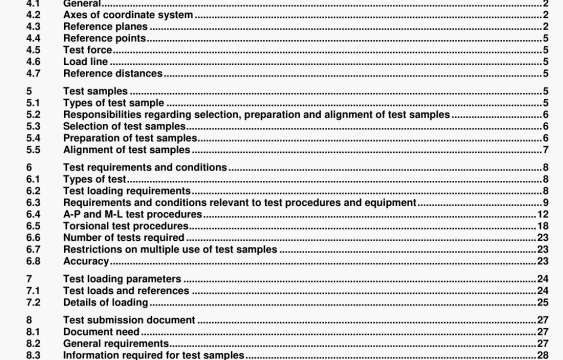ISO 15032 pdf download – Prostheses -Structural testing of hip units.
5.5 AlIgnment of test samples
5.5.1 General requirement
All test samples shall be aligned in aocordance with the responsibilities regarding the alignment of the test samples
(see 5.2) and the requirements specified in 5.5.2.
5.5.2 DescriptIon of effective centres and effective cenireilnes
5.5.2.1 EffectIve kne.-lolnt centreline
For a monocentric knee unit without a lodi. or stance phase control mechanism, the effective kneejoint centreline shall coincide with the joint flex ion axis.
For all other knee units, the effective knee-joint centreline shall be established from the manutactiser’ssubmitter’s written alignment instructions included in or submitted with the test smission document.
The effective knee-joint centreline shall he in the o’. u’• plane of the coordinate system parallel to the effective hip’ joint centreline.
5.5.2.2 Effective knee-point centre
The effective knee-joint centre shall lie on the effective knee-joint cenhreline,
For symmetrical knee units, the effective knee-joint centre shall be the point on the effective knee-joint centreline equidistant from the external boundaries of the unit.
For asymmetrical or handed knee units, the position of the effective knee-joint centre shall be established from the manufacturer’sisubmittefs written alignment instructions for the knee unit included In or submitted with the test sijimission document.
5.5.2.3 Effective hip-joint centreline
For a monocentic hç unit without a lock or stance phase control mechanism, the effective hip-joint centreline shall coincide with the joint ilexion axis.
For all other hip units, the effective hip-joint centreline shall be established from the manufacturer’s/submitter’s written alignment instructions included in or submitted with the test simission document,
The effective hip-joint centreline shall he in the c/. u’-plane of the coordinate system parallel to the c/-axis,
5.5.2.4 EffectIve hip-joint centre
The effective hip-joint centre shall lie on the effective hip-joint centreline.
For symmetrical hip units, the effective hip-joint centre shall be the point on the effective hip-joint centreline equidistant from the external boundaries of the unit.
For asymmetrical or handed hip units, the position of the effective hip-joint centre shall be established from the manufacturer’sisubmitter’s written alignment instructions for the hip unit included in or submitted with the test smission document.
5.5.3 Worst case alignment
The structurally worst alignment position of the test sample shall be defined by the nianufacturer’submitler in the test submission document. It shall lie within the limitations of the manufacturer’s/submitter’s written instructions for the alignment of the limb as splied with every component of the type.
6.12 Cyclic tests
The cyclic tests shall conszst of repeated applications of a load to a test sample.
Each cyclic test shall be followed by a final static load test
6.2 Test loading requirements
6.2.1 Test loading principle
In order to allow the test loading conditions to be applied in a uniform and reproducible manner, the pos.tion of the load line In relation to the test sample shall be established through application of the following test loading pnnc*ple:
ci) for loading, the positions of the load line within the coordinate system shall be such that the test force is applied either in the f’- u’-plane or in the o’- u-plane (see Figures 1 and 2):
e) the test sample shall be assembled to a fixed length using end attachments consisling of extension pieces as required and the load appl.cation levers;
f) the test sample shall be set up either in the (‘- W-plane or in the o’- u’-plane of the coordinate system with the bottom and top load application levers adjusted so that the knee and p offsets are correct;
g) no corrections shall be made to the load application levers ll the test sample deflects under the lest loading conditions, and this deflection alters the initial knee and hip offsets,
62.2 Test loading condItions
6.2.2.1 General
The test loading conditions br A-P. M-L and torsional tests are based on internal reference loads, consisting of an axial force, bending moments and a twisting moment These are described in annex A together with their effects.
NOTE Further reference data are given in annex B together with sevei’al sets of torimslae for calculating speci?C values of axial force. effecave lever arnie and otisels.
6.2.22 A-P plane test loading conditions
In the A-P plane test loading conditions shown in Figures 2 a) and 2 b). the components of loading shall be prockiced by the application of a single test force in theft. u’-plane of the coordinate system.
ISO 15032 pdf download – Prostheses -Structural testing of hip units
